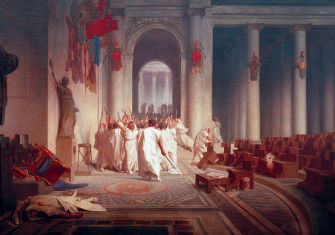
Orpheus and Eurydice
The story of Orpheus and Eurydice is a myth of enduring love that has inspired artists, writers and composers for centuries.
Orpheus and Eurydice, hand in hand, walk away from the fiery underworld and its deities, Pluto and Proserpine. Orpheus, singer, musician and poet, carrying a lyre on his shoulder, had recently married Eurydice, but on the day of their wedding, ‘in the very bloom of her life’, she was bitten by a viper and died of its venom. Distraught with grief, Orpheus descended into the underworld determined to restore her to mortality. He pleaded with Pluto and Proserpine for her return and his eloquence ‘melted the hearts of the gods and the denizens of the underworld, and all fell silent’. Even Cerberus, the fierce three-headed dog that guards the gates of Hell, lies meekly at Proserpine’s feet.
The gods agreed to Eurydice’s return: Proserpine no doubt sympathetic as she recalled her own forceful abduction by Pluto. The only caveat was that Orpheus must not glance back at Eurydice until she was safely ensconced in the upper world. If he broke his word, she would descend once again into Hell.
In Peter Paul Rubens’ painting, Orpheus is depicted struggling to look ahead soon after the deities have consented to her return. On leaving the underworld, the lovers ascended a steep and misty path and, as they neared the earth’s rim, an anxious Orpheus looked behind for his bride, who fell and murmured a final farewell before dying again. ‘No reproach passed her lips’, according to Ovid in his Metamorphoses, because Eurydice now knew for certain that Orpheus loved her unconditionally.
The myth of Orpheus and Eurydice has inspired numerous works of art: in literature, a cast as diverse as Boethius, Rainer Maria Rilke, Thomas Pynchon and Carol Anne Duffy have created variants on its themes, while the filmmakers Jean Cocteau, in his trilogy – The Blood of a Poet (1930), Orphée (1950) and Testament of Orpheus (1959) – and Marcel Camus, with Black Orpheus (1959), have captured its resonant tragedy. Fittingly, it is in music that the myth’s greatest legacy lies. L’Orfeo, Claudio Monteverdi’s opera, the form’s earliest surviving masterpiece, composed in 1607, became the first of many musical dramas to tackle the story: Christoph Willibald Gluck (Orfeo ed Euridice, 1774), Jacques Offenbach (Orpheus in the Underworld, 1858), Harrison Birtwistle (The Mask of Orpheus, 1986) and Anaïs Mitchell’s current Broadway hit Hadestown, set in America’s Deep South, are among those to have added to a canon that continues to expand.
Rubens’ typically vivid Orpheus, which reveals the artist’s deep understanding of classical myth and allusion, was painted in the late 1630s.






